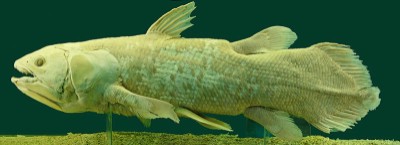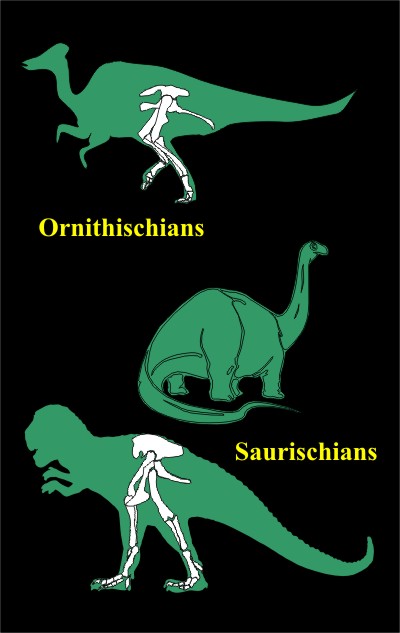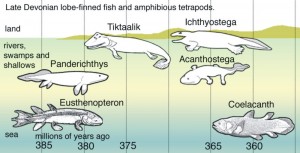Just this past week, an article came out in Nature magazine relating to Panderichthys, a supposed “fishopod.” Bear with me – this is going to be confusing, but that’s not my fault!
If you recall, the evolutionary myth has fish evolving legs and walking up on land, becoming tetrapods (land walkers). Hence the nickname “fishopod” – it’s half-fish, half-tetrapod…. or so certain evolutionists would have you believe.
This week’s ruckus arises from a CT scan of the front fin of a Panderichthys fossil, seen on the right. (To familiarize yourself with CT scans, see the video on the Delk track.)
The purple bone at the top is the bone that anchors to the body, and the little brown bones at the tip are what’s causing all the fuss.
You see, previously, it was thought that the bones at the end of the fin (the two blue, the yellow, and five brown bones) were only two bones. It turns out there was actually six of them (as revealed by the CT scans), and the four small dark brown bones may be “four radials that hint at the future development of fingers.”
To see just how clear the mud is, we need to first take a crash course in fishopod evolution – work with me here!
Wikipedia nicely spells it out for us, in graphic form:
You can see the implied “evolutionary ascent” from fish to fishopod over time. Seeing as how all the fuss is over a fin, I’m going to focus just on the fins, timeline, and supposed evolution.
Let’s first ask the question “Why do they think these fossils show an evolutionary sequence?” The implied answer of course, is that these fossils show improvement and change from fish to tetrapod over time. But even just looking at the fins, the whole story just turns into another fish story real quick! While I don’t believe in these millions of years, and I don’t believe in these “radial bones,” I’m going to meet the evolutionary myth where it’s at and examine the interpretations. I’ll use a chart from Nature so you can see the “evidence” and claims yourself.:
Graphic from Nature magazine.

Eusthenopteron first appears 385 million years ago. It has six radial bones.
Panderichthys, first appearing 380 million years ago, is now believed to have four radial bones.
The Canadian fishopod, Tiktaalik, was found in 375 million year old rock. It’s not known how many radial bones it has, because some of the fossil was missing, but it probably had eight. What’s important here though is that Tiktaalik has a complex ‘wrist joint,” which was claimed to help it walk on land.
Ichthyostega has been found in rocks “dated” at 367 to 362.5 million years old. Because the front flipper/foot was not found, it is not known how many radial bones (if any) it may have had, nor if it had a wrist – however,
Acanthostega, supposedly 365 million years old, did not have a wrist, and had eight radial bones.
So if we were to follow this “fossil sequence,” it would appear that the evolution of the finger has been a wild ride:
First we evolved six fingers, then in our evolutionary ascent we lost two, then gained four back at Acanthostega. Once on land, the number went back down to four (most amphibians have four toes). Apparently we evolved a complex wrist, only to lose it again at Acanthostega, and then apparently re-evolve it back once the critters got onto land.
 In the meantime, what is not shown accurately on the wikipedia timeline above is that the Coelacanth is actually the oldest known creature on that chart! The oldest Coelacanth known is from Australia and dated at over 410 million years old. Although only a jawbone has been found, presumably it’s at least similar to the other Coelacanths we do know of, which have lots of “radial bones” in its fin!
In the meantime, what is not shown accurately on the wikipedia timeline above is that the Coelacanth is actually the oldest known creature on that chart! The oldest Coelacanth known is from Australia and dated at over 410 million years old. Although only a jawbone has been found, presumably it’s at least similar to the other Coelacanths we do know of, which have lots of “radial bones” in its fin!
The Coelacanth has evolved over hundreds of millions of years into… Coelacanths.
So during all this time of Eusthenopteron evolving into Panderichthys, evolving into Tiktaalik, which was supposedly evolving into Ichthyostega and Acanthostega, the Coelacanth remained unchanged and has remained unchanged to this day.
The Coelacanth makes a marvelous study, because before it was found alive, evolutionists were saying the exact same things about it that they are now claiming about Ichthyostega, Tiktaalik, Acanthostega, etc….
In fact, you can still see this bias in modern day reports and websites. For instance,
“the fossilised lung fish – or coelacanth – sets back the timeline for when marine animals made their first excursions on to land….The coelacanth, which the paleontologists describe as a ‘living fossil’ fish with ‘proto legs’, ”
(From I.O.L. Science)
Are these interpretations based on observation? No – because the Coelacanth lives in very deep water, and does not use its fins for anything other than swimming. So what’s this nonsense in the I.O.L. article about excursions onto land? There is no connection – simply evolutionary assumption.
We can observe the Coelacanth behaviour. We can not observe the behaviour of Acanthostega, Ichthyostega, Panderichthys and others because they are not known to be alive now. Therefore, all this talk of using their fins to walk on land is nothing more than wild speculation, the same wild speculation they hurled upon the Coelacanth, which turned out to be false. The evolution of fish to tetrapods is also nothing more than wild speculation.
All of this talk of fish makes me hungry, so I’m going to go fry up some Captain Highliner and some chips. These arguements are arguments from Homology.
The bankruptcy of homology
 Homology is a comparitive similarity between two organisms. For example, in this incredibly complex-looking drawing:
Homology is a comparitive similarity between two organisms. For example, in this incredibly complex-looking drawing:
the bones in the limbs of various animals can be similar in position, structure, etc…
This is a common argument used to promote evolution, as it could be interpreted that these animals all have similar limbs because they evolved from a common ancestor. Thus, they all inherited traits from this one ancestor they all had in common.
It sounds impressive at first, but there a few problems with this interpretation. Bear with me while I get a little technical on ya:
With the fairly new science of genetics, we can now map out what genes hold the blueprints for various parts of our bodies. As a result, we now know that while the bones between two animals may appear to be homologous, the blueprints for these bones come from completely different parts of the genome! Therefore similarity between two organisms is not because of a common ancestor, otherwise, they would also share similar, homologous traits in their genome as well. They do not.
 The similarity between the organisms apparently has nothing to do with a common ancestor, but rather a common designer. One can see a lot of similarities between the early Volkswagens and early Porsches. Is this because they evolved from a common ancestor? No, it’s because they both had a common designer – Ferdinand Porsche.
The similarity between the organisms apparently has nothing to do with a common ancestor, but rather a common designer. One can see a lot of similarities between the early Volkswagens and early Porsches. Is this because they evolved from a common ancestor? No, it’s because they both had a common designer – Ferdinand Porsche.
Homology is only cited when it appears to support evolution. Simultaneously, the lack of homology is ignored when it poses a problem for evolution. For example, a great many evolutionists (and National Geographic) believe that dinosaurs evolved into birds.
Many dinosaurs fall into two classes, based on their hip structure.
The Ornithischians are named after their ‘bird-like hips.’ ‘Orni’ is from the Greek word ornitheos, for ‘of a bird,’ and ‘ischion’ for ‘hip joint.’
The Saurischians include bipedal dinosaurs like T. rex and the Sauropods. They are called this because they have hips like lizards and ‘Saurus’ is the Greek word for ‘lizard.’
So put yourself in the shoes of an evolutionist who believes that birds evolved from dinosaurs. Which group would you assume that the birds evolved from? The Ornithischians? Some of those dinosaurs have bird-like feet, some have bird-like beaks, and they all have bird-like hips.
Or would you assume it was the Saurischians? Some of the Saurischian dinosaurs have elephant-like feet, some have bird-like feet, but no other real similarities to birds. They all have lizard-like hips.
If homology were actually an argument for evolution, the answer would be obvious – it would have to be the Ornithischians. However, the dino-to-bird theorists actually believe it was the Saurischians that evolved into birds!
Clearly homology is not evidence for the evolutionary myth.




